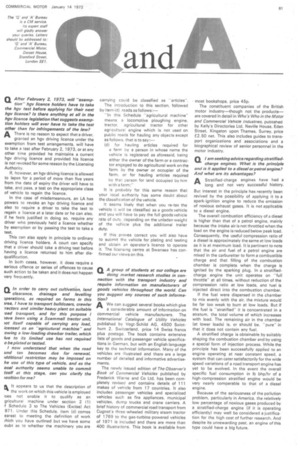Q A group of students at our collage are doing market
Page 63

If you've noticed an error in this article please click here to report it so we can fix it.
research studies in connection with the transport industry and require information on manufacturers of goods vehicles throughout the world. Can you suggest any sources of such information?
AWe can suggest several books which give a considerable amount of information on commercial vehicle manufacturers, The International Catalogue of Utility Vehicles published by Vogt-Schild AG, 4500 Solothurn 2, Switzerland, price 14 Swiss francs plus postage. The book contains extensive lists of goads and passenger vehicle specifications in German, but with an English language key to the technical information. Many of the vehicles are illustrated and there are a large number of detailed and informative advertisements.
The newly issued edition of The Observer's Book of Commercial Vehicles published by Frederick Warne and Co Ltd, has been completely revised and contains details of 111 makes of vehicle from 17 countries. It also includes passenger vehicles and specialized vehicles such as fire appliances, municipal vehicles, dump trucks and crane carriers. A brief history of commercial road transport from Cugnot's three-wheeled military steam tractor of 1769 to the gas-turbine-powered vehicles of 1971 is included and there are more than 400 illustrations. This book is available from most bookshops, price 45p.
The constituent companies of the British motor industry—though not the products— are covered in detail in Who's Who in the Motor and Commercial Vehicle Industries, published by Kelly's Directories Ltd, Neville House, Eden Street, Kingston upon Thames, Surrey, price £2.50 net. This also includes guides to transport organizations and associations and a biographical review of senior personnel in the motor industry.
a, am seeking advice regarding stratifiedcharge engines. What is the principle and is it applied to a diesel or petrol engine? And what are its advantages?
AStratified-charge engines have had a long and not very successful history.
But interest in the principle has recently been revived by the possibility of applying it to a spark-ignition engine to reduce the emission of noxious exhaust gases. It is not applicable to a diesel engine.
The overall combustion efficiency of a diesel is higher than that of a petrol engine, mainly because the intake air is not throttled when the load on the engine is reduced below peak load. Consequently, the useful compression ratio of a diesel is approximately the same at low loads as it is at maximum load. It is pertinent to note that the air and fuel of a petrol engine are mixed in the carburetter to form a combustible charge and that filling of the combustion chamber is complete when the charge is ignited by the sparking plug. In a stratifiedcharge engine the unit operates on "full throttleat all times, without reduction of the compression ratio at low loads, and tuel is injected direct into the combustion chamber.
If the fuel were dispersed in the chamber to mix evenly with the air, the mixture would be far too weak to burn at low loads. But if the fuel is "stratified" it is concentrated in a stratum, the total volume of which increases with load. The remaining air in the chamber (at lower loads) is, or should be, "pure" in that it does not contain any fuel.
A stratified charge is obtainable by suitably shaping the combustion chamber and by using a special form of injection process. While the principle has been successfully applied to an engine operating at near constant speed, a system that can cater satisfactorily for the wide speed variations of a road transport engine has yet to be evolved. In the event the overall specific fuel consumption in lb bhp/hr of a high-compression stratified engine would be very nearly comparable to that of a diesel engine.
Because of the seriousness of the pollution problem, particularly in America. the relatively low percentage of noxious gases produced by a stratified-charge engine (if it is operating efficiently) may well be considered a justification for the high cost of further research. And despite its unrewarding past, an engine of this type could have a big future.
















































































































